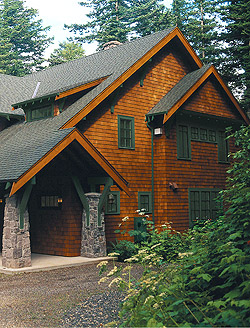
Exterior Wood Stain:
Staining Shingles & Shakes
Modern exterior stains can preserve the beauty of cedar, redwood, and cypress for many years.
by Gail Elber
. Unlike money, shakes and shingles are valuable because they do grow on trees, which require at least a century to produce heartwood of sufficient diameter to make shakes and shingles. Fortunately, modern exterior stains can preserve the beauty of cedar, redwood, and cypress for many years.
Shakes and shingles are made from cedar, redwood, and cypress. As these trees grow, natural oils, tannins, and phenolic compounds accumulate in their heartwood, darkening its color and giving the heartwood resistance to decay and insects. From this heartwood, shakes are split, and shingles are sawn. Lower-cost shakes and shingles cut from the sapwood of these species are also available, but their decay resistance is much less than heartwood’s.
Heartwood from decay-resistant species can last outdoors for 100 years or more — a 300-year-old unpainted cypress and cedar schoolhouse stands in St. Augustine, Florida. However, if they are going to be exposed to the sun, shakes and shingles need protection from the sun’s ultraviolet (UV) radiation. UV breaks down lignin, the glue that holds wood fibers together, allowing water to enter the wood and damage it through cycles of swelling and shrinking.
In stains, this protection is provided by pigment particles, which absorb UV, retarding the rate at which UV turns the wood gray. Pigment also gives color to the wood and evens out its existing color. The smaller the particles of pigment, the more deeply they penetrate into the wood, and the less they obscure the grain.
In oil-based stains, the pigment is suspended in a vehicle that consists of drying vegetable oils, primarily linseed oil, and nondrying petroleum oils, which penetrate both the empty spaces within the cell walls and the voids between the cells. By filling up these spaces, the oils exclude water and minimize shrinking and swelling, reducing stress on the wood and the consequent cracking. Vehicles may also contain waterproofing waxes or resins, and mildewcides to protect the vegetable oils from fungal attack.
Water-based stains function differently from oil-based stains. They coat the cells with pigment and acrylic material and penetrate between them, but do not penetrate the voids inside the cell walls.
Both oil-based and water-based finishes for shakes and shingles are labeled “clear,” “transparent,” and “semitransparent.” A “clear” finish contains no pigment. A “transparent” stain contains the smallest particles of pigment, which penetrate into the wood. “Semitransparent” stains have larger particles that remain on the surface of the wood and form a film. Stains labeled “opaque” are like thin paint, with a high proportion of pigment to vehicle.
Peter Hope, technical specialist with Samuel Cabot Inc., says that water-based stains protect exterior wood for about the same amount of time as oil-based stains. Cabot makes both. Transparent stains last about 2-4 years, semitransparent stains last 3-5 years, and solid-color stains last 6-8 years. The more sun the wall is exposed to, the sooner the stain’s UV protection will fail and the stain will need renewing. The difference between oil- and water-based stains, Hope says, is in how they behave over time; water-based stains retain their color almost to the end of their protective life and then fade suddenly, whereas oil-based stains fade gradually.
Blaine Robles of Norcal Wood Restoration in Marin County, California, likes to start out by letting new shakes and shingles weather in the sun and rain for six months to a year — not long enough for mildew to take hold, but long enough for UV radiation to make the surface porous. Not every stain manufacturer endorses such a long weathering period, so check to see what the manufacturer recommends for your climate.
After this weathering period, Robles uses a pump sprayer to apply a wood cleaner containing oxalic acid and detergent to remove any dirt that has collected and any tannin stains that may have emerged. Then he pressure washes the surface at 2000-3000 psi. To minimize the chance of damaging the wood, his crew is trained to direct the stream of water with the grain of the shingles, and to keep it at a 45-degree angle to the surface. |

